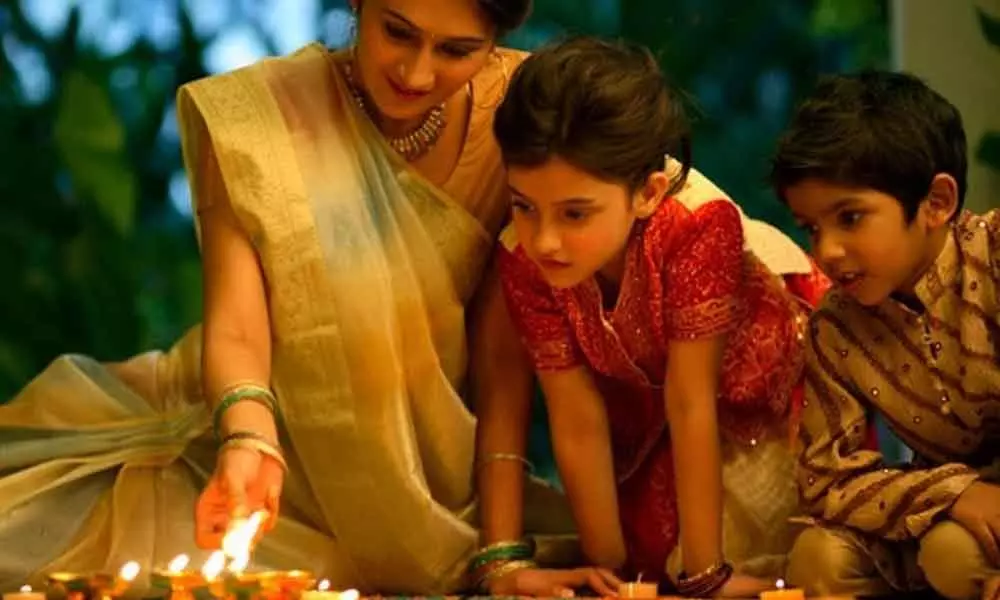Live
- GMR Airports Unveils AI-Powered Digital Twin Platform to Transform Airport Operations
- India poised to become leading maritime player: PM Modi
- Top Causes of Kidney Stones and How to Recognize Silent Symptoms
- India’s renewable energy capacity logs 14.2 pc growth at 213.7 GW
- Winter Session of Odisha Assembly adjourned sine die
- Biden calls Trump's tariff approach 'major mistake'
- After Drama Over Eknath Shinde’s Chief Minister Race, Maharashtra Cabinet Formation Faces New Tensions
- Egyptian FM, Blinken discuss recent developments in Syria
- Iran's supreme leader says Syria's developments result of US-Israeli 'plot'
- Elon Musk to Purchase $100 Million Luxury Mansion Next to Donald Trump's Mar-a-Lago, Report Reveals
Just In

Narrate stories about Diwali: Explain the significance of Diwali to your child by telling them the various stories associated with the festival for example, the tale of Lord Rama’s return to Ayodhya along with Sita or, the killing of the demon Narakasura by Lord Krishna and Satyabhama.
Narrate stories about Diwali: Explain the significance of Diwali to your child by telling them the various stories associated with the festival for example, the tale of Lord Rama's return to Ayodhya along with Sita or, the killing of the demon Narakasura by Lord Krishna and Satyabhama.
There are many other legends around Diwali which make for interesting stories. If you are creatively inclined, you can also write and direct a play depicting these stories. Involve your child and their friends by asking them to play the various characters.
This way, not only will children learn about the festival but also, get the opportunity to showcase their acting talent. If your child and their friends are not old enough, you could instead, create a puppet show around Diwali.
Clean the home: Legend has it that the people of Ayodhya cleaned and decorated their houses with lights to welcome Lord Rama and Sita. That's why cleanliness is integral to the festival.
Ask your child to clean up their room and help you with tidying the rest of the house. Assign age-appropriate tasks — dusting table tops, stacking up newspapers and books, arrange wardrobes and cupboards as well as organising kitchen shelves.
Be charitable: While cleaning and tidying the room, your child may come across toys that they may have outgrown or does not use anymore. Encourage them to share such items with less privileged children you know.
Make greeting cards: A week before the festival, give your child paper and crayons (download images from the Internet to guide him) and ask him to make Diwali greeting cards for close friends and relatives.
This is a wonderful way to bond with extended family and friends, especially those who are unable to visit you on Diwali day.
Decorate the home: Rangolis are associated with Diwali as these add to the beauty of this auspicious occasion.
Give your child a paper stencil or a design downloaded from the Internet and soon they will be immersed in exploring the artistic side. Craft is a sure-fire way of nurturing your child's imagination, creativity and motor development.
Encourage them to make paper lanterns or torans (door hangings) and hang them up on the front door to add to the festive atmosphere.
Make candles, paint lamps: Teens can be allowed to make candles under adult supervision.
To avoid mishaps, ask your child to wear gloves while making candles. The candles can then be decorated with shells and sparkly glue. If you choose to light diyas, buy plain earthen lamps and get your child to paint them.
Plain lamps can also be decorated with mirrors, sequins and sparkly glue. For your child, using something they have made with their own hands will give them a feeling of accomplishment and pride.
Cook together: Diwali celebrations are incomplete without preparing special sweets and savouries. If your child is fond of cooking, you can teach them some simple recipes.
Young children can also contribute in the kitchen by way of peeling cardamom or shaping laddoos. They could then help in storing all the goodies neatly in jars.
Say no to crackers: Explain to your child how bursting crackers cause's air and noise pollution and describe the harmful health effects on humans as well as the environment.
Get your child to become more environment-conscious by asking them to work on a project with this theme, a few weeks before Diwali.
However, if you wish to light a few crackers, keep it to the minimum and try to avoid noisy ones. Diwali can be fun without crackers!

© 2024 Hyderabad Media House Limited/The Hans India. All rights reserved. Powered by hocalwire.com







